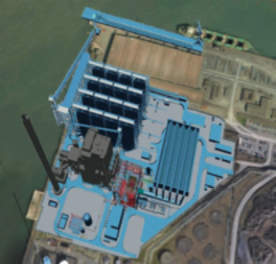
When reduction in CO2 emissions, and emissions in general for that matter, is given priority, biomass fuel, co-fired with coal or used in a dedicated 100% biomass facility, can be an attractive option. However, the term “biomass” necessarily describes a broad range of organic materials. Biomass fuels may include clean wood chips from harvested trees, agricultural residue, salvaged wet forest residues, and manufacturing wood wastes that are very difficult to reliably burn, as well as mixtures of products. Also, the properties of the biomass vary substantially depending on seasonal mixtures, moisture content, and the region where harvested, as well as any fuel pre-processing necessary prior to firing. Biomass can have a wide range of chemical and physical properties and is a much more diverse fuel than coal.
A pulverised coal (PC) boiler that is modified to co-fire biomass will certainly increase its fuel flexibility, but the gains may be relatively limited. For example, a PC boiler that was originally designed to burn coal can be constrained in terms of the amount and type of biomass that can be co- fired due to limitations such as boiler volume and combustion control systems. Retrofitted PC boilers are generally limited to 20% or less biomass by weight, often less than 10%, according to the US Department of Energy (although some PC conversion projects have achieved much higher percentages, up to 100% in some cases, eg Drax in the UK). Co- firing biomass in an existing PC boiler adds complexity to the plant, such as adding a duplicate fuel handling system and other auxiliary equipment. The PC boiler also requires a relatively clean and homogeneous biomass fuel supply, particularly with respect to moisture content, which means fuel must be pre-processed.
New build plant developers demand maximum fuel flexibility so that new facilities can have full access to arbitrage in the global fuel market, maximise use of inexpensive local (but often very poor-quality) fuels, as well as have the ability to co-fire a wide range of locally produced biomass fuels.
The decided trend has been towards using circulating fluidised bed (CFB) technology when fuel-flexibility and utilisation of local fuels (for economic, environmental, and fuel security advantages) are paramount.
The fuel-flexible CFB is able to co-fire biomass with coal in any proportion up to 100% biomass, when sufficient quantities are available. The CFB is also insensitive to biomass fuel type and moisture content and generally requires no preprocessing prior to firing.
An integrated fuel-flexible CFB plant can deliver a number of significant advantages for those considering replacing aging coal-fired power generating plants, particularly district heating plants.
For example, a CFB plant configured as a combined heat and power plant can co-fire a locally sourced brown coal with many forms of locally procured biomass mixtures and bio-sludge. This approach often addresses a multitude of regional environment and energy efficiency problems, such as increasing the overall scale and energy efficiency of a district heating network. In addition, the plant can be sized to meet peak electricity and heat demand thereby producing, at certain times, surplus dispatchable electricity for the local power grid.
This approach ensures regional CO2 emissions are reduced and, if the plant is built within the EU, it will help regional authorities meet refuse derived fuel (RDF) reuse requirements designed to reduce the amount of landfilled material. Depending on the location of the plant, there may also be CHP production and renewable energy system financial incentives available.
The fuel flexibility of CFB technology allows the utilisation of a wide range of renewable and waste fuels and fuel mixes to reduce carbon dioxide emissions compared to conventional generation. The technology also offers high efficiency and significantly increased flexibility in plant operations because a CFB plant can efficiently and reliably burn a broad spectrum of biomass fuels, with or without coal.
The five brief case studies shown illustrate the advantages.
These five biomass-fired combined heat and power plants are significant in terms of their heat and power production capacity as well as also providing major environmental and fuel security benefits. However, there have been fairly tight limits on the size of CFB plant considered capable of burning 100% solid biomass fuels, until now, that is.
MGT Teesside Ltd is building the £650m Tees Renewable Energy Plant, a 299 MWe 100%-biomass-fuelled CHP plant at Teesport, UK (pictured below, source of picture, Sumitomo SHI FW).
When completed, it will be the largest dedicated biomass power plant in the world. Construction of the Tees Renewable Energy Plant (to be featured in the next issue of Modern Power Systems) began in August 2016 and commissioning is scheduled to begin in 2019 with full commercial operation expected in early 2020.






